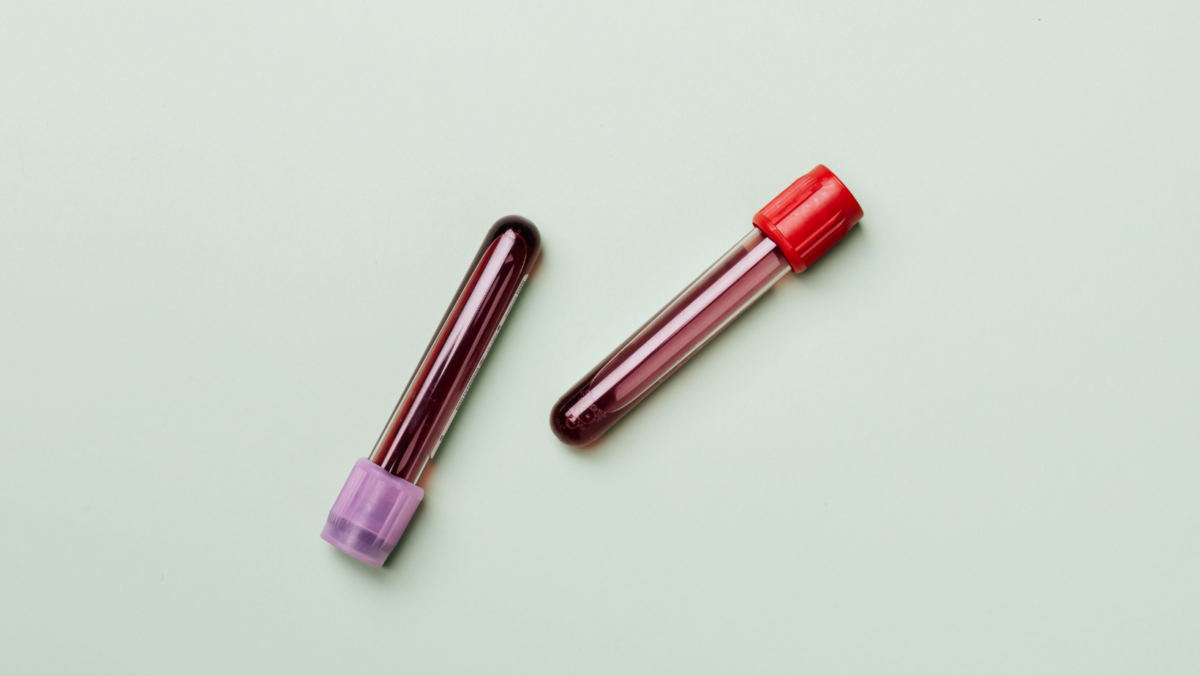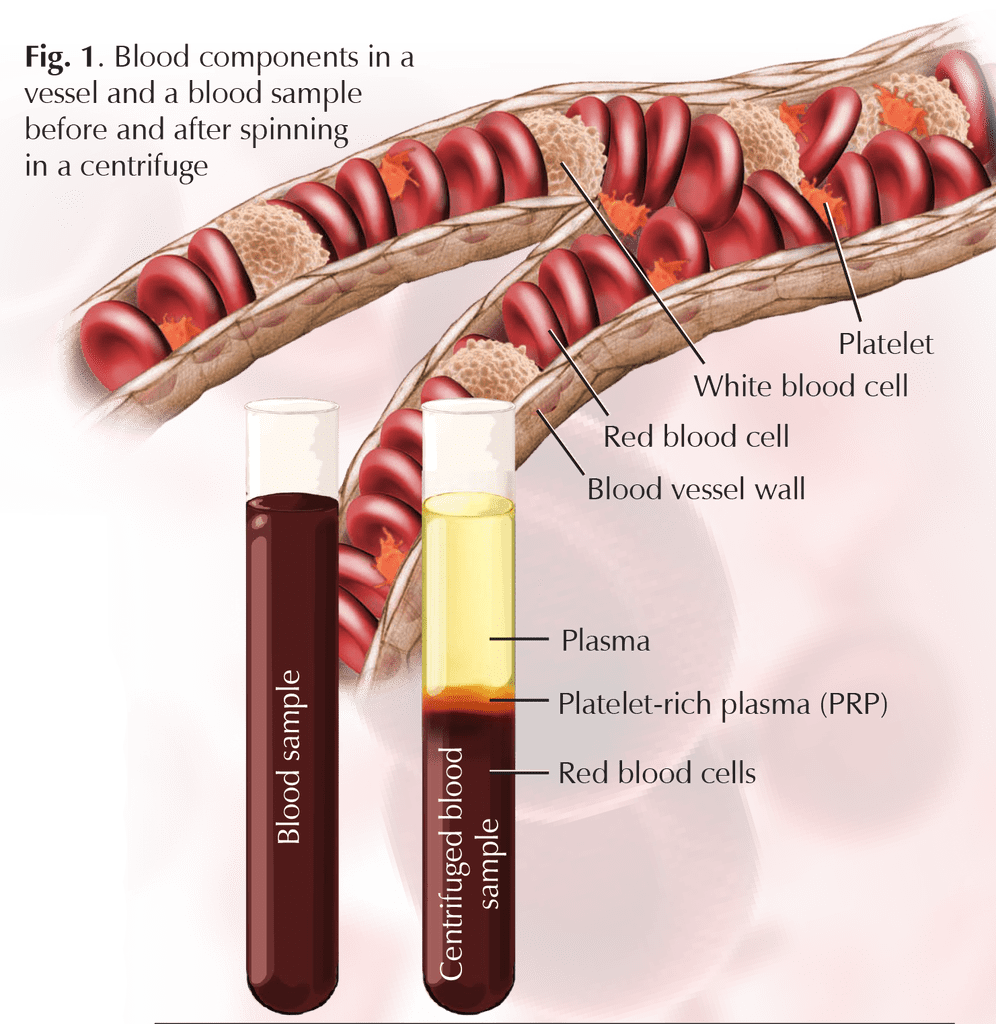Contributing physicians in this story

What is Platelet-Rich Plasma Therapy?
Platelet-rich plasma (PRP) therapy has been around in some form since the mid-1990s. Lately, it has received considerable attention for its potential for treating chronic tendonitis and acute sports injuries. PRP therapy is a nonsurgical treatment that can slow, halt or possibly even heal progressive damage of:
- bones
- cartilage
- muscles
- tendons
- ligaments (tissue connecting one bone to another)
It also has the potential to reduce pain and improve joint function. PRP therapy works by making use of the natural healing properties of the platelets found in blood plasma.

Plasma and platelets are 2 of the 4 components of blood; the other 2 include red and white blood cells (Fig.1). Plasma is the pale yellow liquid component of the blood. It consists of 95% water and makes up 55% of the total blood volume. Plasma transports blood cells along with platelets and other molecules such as hormones and antibodies throughout the body. Platelets, or thrombocytes, are colorless, microscopic disc-shaped cell fragments with no nucleus that are made in the bone marrow or spongy center of bones.
While known primarily for their role in clotting blood, platelets also transport smaller proteins called growth factors that can stimulate the body’s own healing response. For example, when soft tissue is injured, the body’s first reaction is to deliver platelets to the area where they prevent bleeding, initiate tissue repair, and can attract the assistance of stem cells (cells capable of reproducing and differentiating).
To produce plasma that is rich in platelets, a sample of blood is drawn and spun in a machine (centrifuge) at an extremely high speed to separate the platelets and plasma from the blood cells. The resulting fluid has a high concentration of platelets and thus of growth factors. This PRP fluid can then be injected into an injured area to help accelerate healing.
What are the potential uses of PRP?
Treatment with PRP can help reduce pain in patients who suffer from chronic conditions such as a tendon injury, muscle strain, ligament sprain, or osteoarthritis. PRP treatment may also promote healing in surgical patients.
Tendon injuries

For individuals with chronic tendon injuries, PRP has become an attractive option, partly because these injuries have traditionally been difficult to treat. Generally, rest, activity modification, oral or topical anti-inflammatory medications, selective cortisone injections, physical therapy, and bracing are the recommendation. When these treatment modalities fail to relieve the pain, surgery is usually the best option. During surgery, the portion of the tendon suffering from damage is removed, and the tendon is then repaired by suturing the healthy ends together.
But what if we could instead stimulate the body to heal the damaged tissue?
Previous orthopedic research has focused on the use of PRP to treat chronic tendon injuries such as lateral epicondylitis (tennis elbow), patellar tendonitis (jumper’s knee)(Fig. 2), Achilles tendonitis, and plantar fasciitis. PRP seems to be most effective in treating lateral epicondylitis, often working better than cortisone injections. Although pain relief was noted when PRP treatments were performed on the elbow, whether the tissue actually regenerated was not determined. Moreover, research has not yet confirmed whether PRP therapy is more effective than standard treatments for other types of chronic tendon injuries. There are 2 principal reasons for this uncertainty: 1) we do not know the exact concentration of platelets needed; and 2) we do not know the precise number or the proper timing of injections to treat each condition.
Strains and sprains
PRP therapy may also be an option for treating other musculoskeletal conditions, including acute injuries such as muscle strains and ligament sprains, particularly of the knee and elbow. Recently, PRP therapy gained national attention in the sports medicine field when some professional athletes, including 2 members of the Pittsburgh Steelers and pro-golfer Tiger Woods, underwent treatments to speed up the healing process and their return to competition. While this does sound promising, only further research will confirm whether PRP therapy can truly produce these benefits.
Osteoarthritis
Osteoarthritis, or loss of cartilage in the joints, is the most common type of joint disorder and a significant cause of pain for sufferers. Currently, there is no cure for osteoarthritis. Ultimately, when joints such as the knee or hip suffer from severe damage, arthroplasty (surgical joint replacement) is the only option for relieving pain and regaining mobility. Studies are currently underway to determine whether PRP injections are effective in reducing pain and even slowing down deterioration in these arthritic joints.
Surgical supplement
Another potential use of PRP is as a supplement during certain types of surgeries—for example, rotator cuff tendon repairs and fracture repairs—to promote the healing of tendons and bones. It is also a possibility for use in surgeries to help repair or reconstruct torn sections of cartilage. Further research into this treatment modality will help to determine whether PRP therapy can fulfill its promise.
Platelet-Rich Plasma Therapy: not for everyone
A patient who may be a good candidate for PRP is one that
- has tried various nonsurgical treatments – such as rest from activity, bracing, and physical therapy
- continues to experience symptoms for longer than 6 months
PRP therapy is not for everyone, however. Because the treatment does not currently have approval from insurance companies, patients must assume the full cost. Moreover, patients with cerebral palsy or Parkinson’s disease are not good candidates. The therapy is also not for those patients who are undergoing treatment for cancer or for infections such as hepatitis. Additionally, PRP therapy is not suitable for patients who suffer from multiple medical conditions, bleeding disorders, or who have been prescribed a high dosage of Coumadin®, Plavix®, or other blood thinners
A promising option
When appropriate, Platelet-Rich Plasma Therapy presents an attractive option for patients and physicians alike. It may create a superior healing environment and speed healing time for certain types of surgically repaired tissues; it should thus allow individuals to return to work or sports sooner. Moreover, PRP therapy may offer pain relief or even eliminate the need for surgery in patients with a number of chronic conditions, such as tendon problems and arthritis. Furthermore, no significant side effects have been associated with PRP use; the chief complaint has been temporary pain at the injection site. PRP thus remains a promising option to treat and potentially cure a number of different types of musculoskeletal conditions.
Author: Kevin J. Collins, MD | Valdosta, GA
Reprinted with permission from the Hughston Health Alert, Volume 28,Number 3, Summer 2016.
Last edited on March 20, 2023